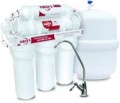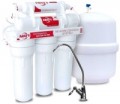Stages of purification
The number of purification stages provided for in the filter design. At each stage, water passes through its own filter element, clearing itself of certain contaminants; in this case, the steps are arranged in order from coarser cleaning to finer. For example,
a three-stage system may look like this: the first stage is mechanical removal of impurities, the second stage is the removal of ferrous, and the third is filtration through a carbon cartridge.
The more stages of purification — the more advanced the filter is considered, the cleaner water it usually provides at the outlet. Accordingly, this moment largely depends on the purpose (see “Type”): for example, multi-stage filtration is quite rare in main models, it is practically not used at all in pre-filters, but the number of stages can reach 9 in models for sink.
Water mineralization
The presence of a
water mineralizer in the filter design. The mineralizer is usually a container filled with a special slowly dissolving mixture. Thanks to it, filtered water is saturated with various micronutrients: calcium, potassium, fluorine, ferrous (of course, not harmful colloidal ferrous, but another easily digestible form) and others. They have a positive effect on the human body and improve the taste of the water itself compared to completely purified water.
Mineralizers are found mainly in filters equipped with reverse osmosis systems (see above): the fact is that during the operation of such systems, not only harmful impurities are removed from the water, but also the mentioned micronutrients that got there naturally.
Min. operating pressure
The lowest inlet water pressure at which the filter is able to fully perform its functions. Indicated for models with a connection to the water supply — directly or through a tap (see "Connection").
The design of some filters requires a certain level of inlet pressure for normal operation; if the pressure is insufficient, both throughput and overall filter efficiency suffer, and some functions are not available at all. The latter is especially true for reverse osmosis (see above). Therefore, if the minimum operating pressure is directly indicated in the filter characteristics, you should make sure that your water supply system complies with this parameter before purchasing.
Note that for filters with a booster pump, this column indicates the lowest pressure at which the filter still does not require the use of a pump; see "Pump" for details.

